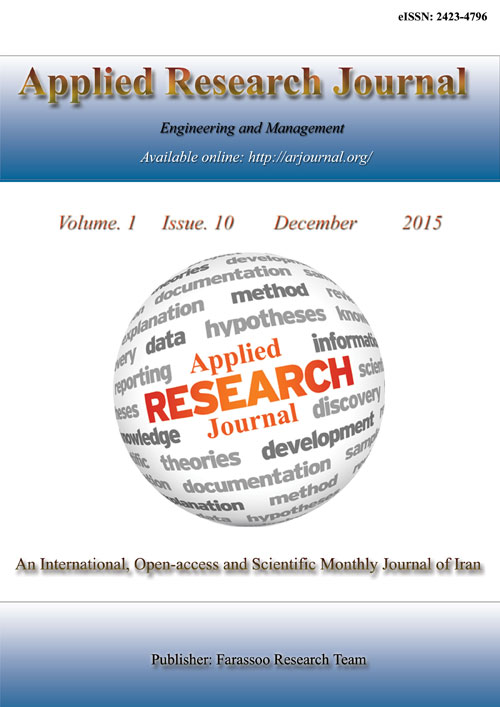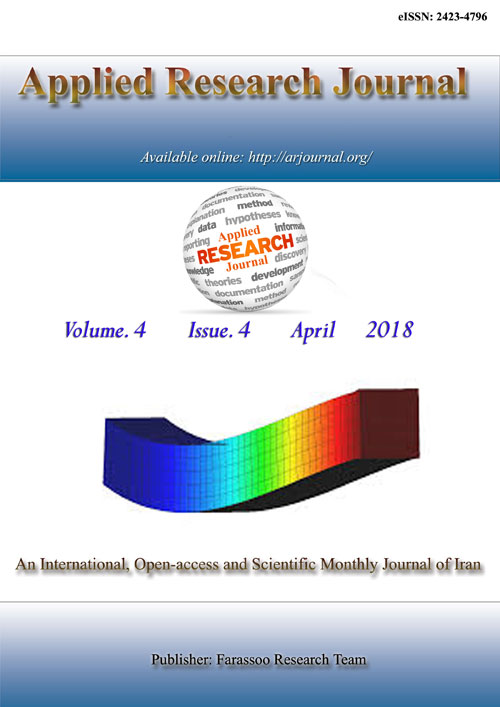فهرست مطالب

Applied Research Journal
Volume:1 Issue: 10, Dec 2015
- تاریخ انتشار: 1394/09/25
- تعداد عناوین: 4
-
Page 478The main object of this paper is to highlight sustainable building strategies and reality of implementing those strategies in the design of buildings in Iraq. That object was achieved through two stages, at the first stage a theoretical study was conducted to identify sustainability principles in buildings, at the second stage a practical study was conducted through personal interviews and open questionnaire, then a closed questionnaire was conducted to determine the reality of applying sustainability principles in buildings design. results of the practical study showed that there was a clear weakness in implementing sustainable building principles specially in the field of building materials which can be attributed to some reasons which were divided into administrative and technical reasons. a number of recommendations were proposed according to the research results in order to improve buildings design towards sustainable building in the future.Keywords: Sustainable building, Building designs, Resource conservation, Sustainable materials.
-
Page 490Rural management is combination of Islamic rural council and rural Managers (in Persian=Dehyar). An important role of the rural managers and the Islamic rural council is environmental protection. Waste is an important challenge for environment and the rural managers must manage it. Aim of this paper is study of methods and components that the rural managers used it for environmental protection. Investigative method is descriptive-analysis and we use from questionnaire for collecting data. We use from SPSS software. Statistical society included 60 the rural managers and 14 rural council members. Results show that there are 6 components in the waste management by the rural mangers that include: corporation between the rural managers and the Islamic rural council, problem of destruction of waste, corporation people with the rural managers, knowledge about waste and facilities. Finally we understand that rural people and government are important for waste management. It is essential that we develop culture of waste management in the villages.Keywords: Waste, Waste management, Rural Management, Rural managers, Islamic Rural Council.
-
Page 494The aim of this study is to investigate the behavior of composite castellated beam in which the concrete slab and steel beam connected together with headed studs shear connectors. Four simply supported composite beams with various degree of castellation were tested under two point static loads. One of these beams was built up using standard steel beam, i.e. without web openings, to be a reference beam. The other three beams were fabricated from the same steel I-section with various three castellation ratios, (25, 35, and 45) %. In all beams the concrete slab has the same section and properties. Deflection at mid span of all beams was measured at each 10 kN load increment. The test results show that the castellation process leads to increase the moment capacity of composite beams at permissible deflection that is (span/360) in the range of (11- 96) %. On the other hand, the maximum measured deflection was reduced in the range of (7.8 – 27.1) %.Keywords: Castellated beams, Composite beams, Steel structures, Moment capacity.
-
Page 501Ready to eat foods play a significant role in feeding the urban population with cheap, accessible and nutritious foods. This study aimed at assessing the bacterial colonizers, of snacks (ready to eat food) sold in within Maiduguri to determine its safety for consumption. Ready to eat food can lead to food poisoning and consequent food borne illnesses. Standard microbiological methods were used for isolation, enumeration and identification of bacteria. This study was carried out to investigate bacterial safety in the vending of street foods in Maiduguri, namely: University Maiduguri, Mr. Biggs and a local kiosk were analyzed for total heterophic bacteria count on nutrient agar plates. Local kiosk showed the highest bacteria count of meat-pie 4 × 103cfµ, buns 6 × 103cfµ and doughnut 11 × 103cfµ, followed by UNIMAID; meat-pie 1 × 103cfµ, buns 5 × 103cfµ and doughnut 9 × 103cfµ, then Mr. Biggs with the lowest bacteria load; meat pie 1 × 103cfµ, buns 1 × 103cfµ and doughnut 3 × 103cfµ. Four (5) different bacterial isolates were identified which are Staphylococcus epidermidis, Bacillus subtilis, Staphylococcus aureus and Corynebacteria speices. The frequency of bacteria isolated and the percentage of occurrence of bacterial isolated were analyzed in relation to all the retail outlet, were the highest are Staphylococcus aureus 50%, Bacillus subtilis and Corynebacteria speices 21.43%, Staphylococcus epidermidis 7.14% which may be due to the poor sanitary practices by food personnel and could be an indication of possible feacal contamination. The most predominant bacterial contaminants was Staphylococcus aureus with 50%, this could be traced to the fact that it is abundant in human body (skin, nails, hair), staphylococcus epidermidis with 7.14%, is normally found on the skin which can cause urinary tract infections, 21.43% Bacillus species and were isolated; however, pseudomonas species were not detected. Adoption of good manufacturing practice and hazard analysis critical control point (HACCP) are necessary to preventing occurrence of food borne illness.Keywords: Food safety, Pathogens, Snacks, Ready to eat foods, food borne illnesses.


